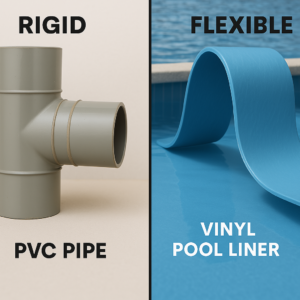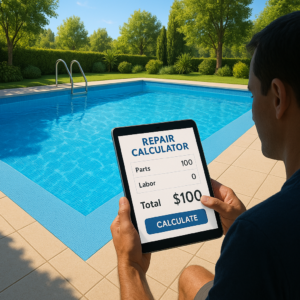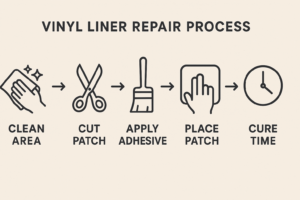Can I Use PVC Cement on the Vinyl Pool? An Expert Guide
If you own a pool with a vinyl liner, you might have wondered, “Can I use PVC cement on my vinyl pool?” This guide explains the answer and teaches you the best repair methods. You will learn the differences between PVC cement and vinyl pool liners. We will also cover safe repair techniques and practical tips. This post is a complete guide for pool owners who want to fix their pool without damage.
In this guide, you will learn:
- What PVC cement is and why it is not for vinyl liners.
- The special properties of vinyl pool liners.
- Safe repair methods and products you should use.
- A comparison of repair options with tables and diagrams.
- Step-by-step instructions and troubleshooting advice.
Let’s start with a quick background. PVC cement is a strong adhesive for joining rigid PVC pipes. It works by softening the plastic so that two pieces fuse together. Vinyl pool liners are made from a flexible material. Their ability to bend and move is very important. Using the wrong adhesive can lead to cracks and leaks. In the next sections, we will break down the differences and give you the facts you need.
Introduction
Vinyl pool liners are a common choice for many pool owners. They provide a smooth, waterproof barrier for your pool. However, they are also delicate. They need to remain flexible to handle water pressure and temperature changes. This flexibility is one of the pool liner’s most important features.
PVC cement, on the other hand, is made for rigid PVC pipes. Its job is to chemically melt and join hard plastic. This process works well in plumbing systems. But, when you try to use PVC cement on a flexible vinyl liner, the results can be poor. The solvent in the cement can damage the vinyl, causing it to crack or tear.
Many pool owners are tempted to use PVC cement for a quick fix. But using it on a vinyl liner can lead to long-term problems. Damage may occur over time, and the repair may not hold. This can lead to leaks and expensive repairs later on.
In this post, we will explore the science behind PVC cement and vinyl pool liners. We will discuss why they are not compatible. We will also share safe repair methods and products that are designed for vinyl. Whether you have a small tear or a seam that needs fixing, you need the right tools and techniques. This guide provides step-by-step instructions and expert tips to help you make the best choice.
By the end of this post, you will know why PVC cement is not the answer for vinyl pool repairs. You will learn the proper alternatives and see a clear comparison of your options. You will also be introduced to a useful repair calculator tool that can help you plan your next repair. Let’s dive into the details.
Understanding PVC Cement and Vinyl Pool Liners
What is PVC Cement?
PVC cement is a solvent-based glue designed for rigid PVC. It works by chemically melting the surface of the PVC so that two pieces fuse into one strong joint. Here are the key points:
- Purpose: Used for rigid PVC pipes and fittings in plumbing.
- Action: Softens plastic surfaces and then fuses them permanently.
- Result: Creates a strong, inflexible bond.
Characteristics of Vinyl Pool Liners
Vinyl pool liners are made from a flexible form of polyvinyl chloride. Their flexibility is key. They must move with the pool structure and adjust to changes in water pressure and temperature. Here are some details:
- Material: Specially formulated flexible PVC with plasticizers.
- Flexibility: Allows for movement without damage.
- Waterproof: Provides a leak-proof barrier for the pool.
Why PVC Cement is Not Suitable
Using PVC cement on a vinyl liner can be dangerous. The cement is made for hard, non-flexible materials. Its solvents can over-soften or even damage the vinyl liner. Here are the main reasons:
- Chemical Mismatch: The solvents in PVC cement can harm the vinyl’s plasticizers.
- Lack of Flexibility: The bond becomes rigid and cannot bend with the liner.
- Potential Damage: The adhesive may cause the liner to crack or tear.

A pool owner may see a temporary bond, but over time, the damage will show. Experts and manufacturer guidelines strongly advise using products made for flexible vinyl.
Comparative Analysis: Repair Options for Vinyl Pool Liners
Let’s compare repair options. Below is a table that contrasts PVC cement and vinyl-specific adhesives. This table shows key differences in composition, flexibility, and application.
Table 1: PVC Cement vs. Vinyl Adhesive Comparison
Table 2: Recommended Products for Vinyl Repairs
Diagram: Repair Process Flow
Below is a simple HTML diagram showing the steps for a vinyl liner repair. This diagram helps you see the process at a glance.
Performance Factors
Understanding the factors that affect repair success is key. Below, we rank and explain the most important factors:
-
Flexibility of Adhesive:
The adhesive must allow the liner to move. Vinyl adhesives are designed to flex, while PVC cement is rigid. -
Chemical Compatibility:
The repair product must not harm the vinyl. The wrong chemical can weaken the liner. -
Curing Time:
Proper curing ensures a strong bond. Faster curing is good but must be balanced with effective adhesion. -
Application Conditions:
Some adhesives work underwater, which is ideal for pool repairs. Check if the product supports wet application. -
Durability Under Pressure:
The repair must hold up under water pressure and temperature changes. This ensures long-term safety.
Visual Representation of Factor Interaction
Below is an HTML diagram that shows how these factors interact:
Each factor plays an important role. A flexible and chemically safe adhesive is essential for a strong repair.
Implementation Guide
This section provides a clear, step-by-step process for repairing a vinyl pool liner with the correct adhesive. Follow these instructions carefully.
-
Gather Supplies:
- Vinyl-specific adhesive (e.g., HH-66 Vinyl Cement)
- Vinyl patch or repair kit (e.g., Boxer Vinyl Repair Kit)
- Cleaning cloth and mild detergent
- Scissors or a utility knife
- Application brush
-
Prepare the Area:
- Drain water if needed.
- Clean the damaged area thoroughly.
- Dry the area completely.
-
Cut the Patch:
- Cut a patch that is slightly larger than the damaged area.
- Round the edges of the patch to avoid peeling.
-
Apply the Adhesive:
- Apply a thin, even layer of vinyl adhesive to both the patch and the liner.
- Follow the manufacturer’s directions for drying time.
-
Place the Patch:
- Press the patch firmly onto the damaged area.
- Smooth out any air bubbles with your hand or a tool.
-
Allow to Cure:
- Let the adhesive cure as instructed (usually 24-48 hours).
- Do not disturb the area until the adhesive is fully set.
-
Test the Repair:
- After curing, check the repair for leaks by refilling the pool gradually.
- Monitor the patch over a few days to ensure durability.
Expert Tips:
- Always work in a well-ventilated area when using adhesives.
- Follow all safety instructions provided by the adhesive manufacturer.
- Keep a repair kit handy for emergency fixes.
“Using the right adhesive for your vinyl pool liner is essential. A proper repair saves you time and money in the long run.”
– Pool Maintenance Expert
Warning:
Do not use PVC cement on the liner. It may cause irreversible damage.
Troubleshooting Common Issues
Even with the right adhesive, problems can occur. Here are common issues and simple fixes:
-
Adhesive Fails to Bond:
- Cause: Surface not clean or dry enough.
- Fix: Clean the area again and let it dry fully. Reapply adhesive.
-
Patch Lifts Off:
- Cause: Insufficient pressure during application.
- Fix: Apply firm pressure and ensure no air bubbles are trapped.
- Tip: Use a roller or a flat tool to smooth the patch.
-
Visible Bubbles Under the Patch:
- Cause: Air trapped during application.
- Fix: Gently press out air bubbles before the adhesive sets.
-
Discoloration Around the Repair:
- Cause: Chemical reaction between the adhesive and the liner.
- Fix: Test a small area first. If discoloration occurs, consult a pool professional.
-
Adhesive Dries Too Fast or Too Slow:
- Cause: Environmental temperature and humidity.
- Fix: Follow manufacturer guidelines. Adjust the curing time based on conditions.
“Proper surface preparation is half the battle in pool repairs.”
– Renowned Pool Technician
A clear, step-by-step troubleshooting process will save you from future headaches. Always test your repair on a small area before a full application.
Innovation and Extended Applications
Beyond basic repairs, innovative methods are emerging in vinyl pool maintenance:
- Advanced Vinyl Adhesives: New adhesives now offer improved underwater bonding. They work faster and create a more durable patch.
- Heat Welding Techniques: Some professionals use heat welding for larger repairs. This method fuses the vinyl without extra adhesives.
- Smart Repair Kits: These kits include sensors to check the patch’s durability over time. They alert you if a repair begins to fail.
- Eco-Friendly Products: New repair adhesives are designed to be safer for both the environment and pool users.
- Customizable Solutions: Emerging products allow you to choose different adhesives based on your pool’s specific needs. For example, some adhesives are best for high chlorine environments while others excel in UV resistance.
The pool repair market continues to evolve. Keeping up with the latest innovations can help you extend the life of your pool liner and prevent leaks. Always check for new product reviews and guidelines.
Long-term Considerations
When planning a repair, think long term. Here are some key points:
-
Sustainability:
Use repair products that are proven to last. A good repair saves money over time and avoids waste. -
Maintenance Requirements:
Regular checks can catch minor issues early. A well-maintained pool liner lasts longer. -
Longevity Estimates:
With proper care, vinyl liners can last 7-15 years. Quality repairs can extend this lifespan. -
Upgrade Indicators:
If you notice repeated repairs or fading patches, it may be time for a full liner replacement. -
Cost-Benefit Analysis:
Spending a little more on a high-quality adhesive now can prevent expensive repairs in the future.
Expert FAQ Section
Below are expert answers to common questions:
Q1: Can I use PVC cement on my pool plumbing?
A1: Yes, PVC cement is perfect for PVC pipes and fittings in your pool’s plumbing system. It creates a strong, permanent bond.
Q2: What happens if I accidentally use PVC cement on my vinyl liner?
A2: The adhesive can weaken or damage the liner. Even if it sticks at first, the patch may fail over time due to inflexibility.
Q3: Are vinyl repair kits effective underwater?
A3: Many vinyl repair kits are designed for underwater use. They include adhesives that bond even when wet, ensuring a durable fix.
Q4: How long does a vinyl adhesive need to cure?
A4: Curing times vary, but most adhesives need 24 to 48 hours to set properly. Follow the product instructions closely.
Q5: What should I do if my repair fails?
A5: If the repair fails, clean the area, and try again with a new patch and fresh adhesive. If problems persist, consult a professional.
Q6: How much does a proper vinyl repair kit cost?
A6: Prices vary, but quality kits usually cost between $20 and $50. The cost is worth it to avoid larger repairs later.
Q7: Can these repair methods be used on other vinyl items?
A7: Yes, many vinyl adhesives work on pool liners, inflatable toys, and other flexible vinyl products. Always check product compatibility.
Conclusion
In summary, you should not use PVC cement on a vinyl pool liner. PVC cement is made for rigid PVC pipes, and it creates a bond that is too inflexible for a vinyl liner. This can lead to cracks, leaks, and further damage. Instead, use a vinyl-specific adhesive or a dedicated repair kit designed for flexible vinyl.
This guide has shown you why proper repair matters and how to choose the right product. With step-by-step instructions and troubleshooting tips, you can make a lasting repair that saves you time and money. Now that you know the facts, take action to protect your pool investment.
Your next step is to research the best vinyl repair products available. Consider investing in a repair calculator tool to help plan your repairs. A well-chosen tool will let you calculate the patch size, adhesive quantity, and curing times based on your pool’s dimensions.

Additional Resources
For more detailed information and expert tips, check out these sources:
- Pool & Spa News: Articles on pool maintenance and repair tips.
- Swimline: Manufacturer guides on vinyl pool liner care and repair.
- Home Depot Pool Repair Guides: DIY tips for pool repairs.
- This Old House: Expert advice on home and pool maintenance.
- Reddit Pool Maintenance Forums: Community discussions with real-life experiences.
Technical Glossary
Below is a glossary of 10 technical terms used in this guide:
- Adhesion: The ability of a substance to stick to another surface.
- Curing: The process of an adhesive hardening and setting properly.
- Flexibility: The ability of a material to bend without breaking.
- Plasticizers: Chemicals added to plastics to increase flexibility.
- PVC (Polyvinyl Chloride): A type of plastic used in pipes and pool liners.
- Rigid PVC: Hard PVC used in plumbing systems.
- Solvent: A chemical that dissolves a material.
- Solvent-based Adhesive: An adhesive that works by dissolving surfaces for bonding.
- Waterproofing: Making a material resistant to water penetration.
- Underwater Adhesive: An adhesive that can set and bond in wet conditions.
By following the guidelines in this expert guide, you can protect your vinyl pool liner and ensure long-lasting repairs. Always choose the right adhesive for the job. Remember, a proper repair saves you from costly future fixes and keeps your pool safe and enjoyable.
Ready to make your next repair a success? Dive into the details, use the right tools, and keep your pool in top shape!
We invite your feedback on this guide. Let us know if you need more details or additional insights on any section. Happy repairing!

